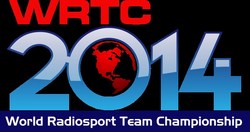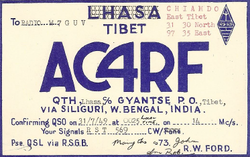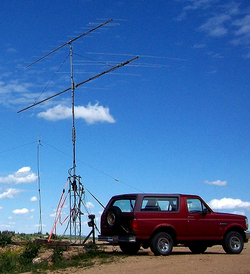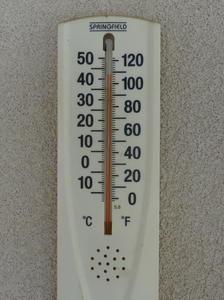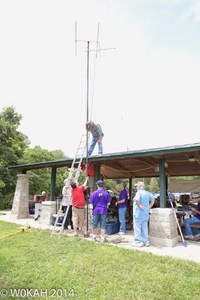 July 2, 2014 Editor: Ward Silver, NØAX | |||||||||
IN THIS ISSUE
NEW HF OPERATORS - THINGS TO DO The biggest event out there for you is, of course, WRTC2014 which runs in parallel with the IARU HF Championship. The upcoming two-week period also has a large number of short CW and digital "sprints" lasting from 30 minutes to 6 hours. Find one to fit your schedule and give it a try! BULLETINS The RTTY NS Sprint Contest will continue including 15 meter operation into September. (Thanks, N6RO) BUSTED QSOS Nothing out-of-line in the previous issue was reported. CONTEST SUMMARY Complete information for all contests follows the Conversation section July 5-6
July 12-13
Organizers of the 2014 World Radiosport Team Championship have announced that there will be a live scoreboard for tracking the team standings during the event on July 12-13. The Live Scoreboard will be directly accessible online or from a link on the WRTC2014 website. The site uses responsive design principles to provide maximum usability on desktop, tablet, and mobile platforms. The scoreboard uses an innovative data collection method developed by Dave Pascoe, KM3T and Bob Raymond, WA1Z. Each WRTC2014 team will be using networked computers to log the contest. The score collection system will "sniff" the network traffic to obtain the latest score and QSO breakdown information. This data will be transmitted by cellular modem every five minutes back to the score processing web site. Previous WRTC events used manual score submissions on an hourly basis. This will be the first to use automation to present scores in near real-time. The web site will show the scores of all teams ordered by score. The team's band breakdown, hourly rate sheet, and position for each hour of the contest will also be available. A leader board page will list the top five teams by CW contacts, SSB contacts, multipliers, and points per QSO. Another innovation is the ability to select multiple teams and compare their scores on a graph vs time. This will reveal how the fortunes of teams change over the 24 hours as they follow their various strategies for building their score.
Teams will be shown by the calls of the team members rather than their over-the-air call sign. This is done to maintain fairness by keeping the team identity behind each call sign a secret. The teams are not allowed to identify themselves over the air except by their competition call sign. While you're at WRTC or maybe visiting New England in the future there is "lots of other radio/electro-geek history in the area, " such as the Marconi and Maritime Center in Chatham, although the original Marconi station is nearly lost to erosion.
Force 12 / InnovAntennas America reports doing land-office business during the first part of this year with 198 orders equaling the Force 12 bookings from all of 2013. Bill AA7XT acknowledges the surge in orders took them by surprise. As much as he regrets anyone having to wait for their antenna, however, the backlog is steadily being eliminated, having filled 82% of all orders as of June 30. The new XR Series of Yagis designed by Justin GØKSC are doing quite well and the goal is to build up inventory to support same-day shipping of XR-3, XR5-T, and XR6 antennas. To that end, two new permanent factory staff are on the job in Grand Junction, CO under the supervision of factory manager, David McKay. The public preview period for the CQ WW DX Contest rules for 2014 ended on July 1 but you can see the proposed rule changes on the CQ WW blog of CQ WW Director, Randy K5ZD For those of you who remember the legendary W3CRA site, Bill W4ZV once created a model for the site and evaluated it using HFTA. His discussion includes some interesting anecdotes and photos as well as the HFTA results. Ever wonder where the phrase "The Deserving" came from or perhaps who invented the Big Bass Bongo? Wonder no more because The West Coast DX Bulletin is back! Written by the legendary Hugh Cassidy WA6AUD, the bulletins are now available for everyone to enjoy online including very issue from Volume 1 number 1 up to and including the very last issue from 1979. Made available by the Northern California DX Club, the collection will be moved to its permanent home in the W6CF Memorial Library at the California Historical Radio Society in Alameda, CA. (Thanks, Rusty W6OAT) After a bit more than four years, the NCDXF-IARU Beacon 4U1UN has resumed transmitting. The beacon was deactivated during the UN HQ Building renovation and was put back on the air Wednesday, June 18 by James K2QI, the 4U1UN station manager and President of the UN Amateur Radio Club. If you are not near a radio, you can see NCDXF Beacon System activity on the Reverse Beacon Net system. (Thanks, Steve K6UM) Louis Frenzel W5LEF's Electronic Design blog, Communiqué, discusses the booming business of Do It Yourself electronics and its effect on encouraging students to take an interest in STEM careers. Sounds a lot like ham radio, doesn't it?
Recently, backyard photographers have been observing gigantic red sprites flickering over the USA. These electrical discharges, which occur high above thunderclouds, resemble enormous jellyfish and their glow can often be seen hundreds of miles away. One specimen highlighted recently on the Space Weather website would dwarf Mt. Everest, reports the photographer, Thomas Ashcraft. It would be interesting to see whether sprites sometimes masquerade as sporadic E clouds and if meteor scatter communication via sprites has any identifiable characteristics distinguishable from true Es. Barry W6YE discovered this Dutch website called the Cryptomuseum. The site includes a lot of information on old radios, spy sets, and you can even order a kit to build your own Enigma machine! Web Site of the Week - In parallel with WRTC, a European team has created an online "virtual" competition, the European Radiosport Team Championship (ERTC). 100 young operators will be traveling to Finland to take part in Youngsters On the Air (YOTA) on July 19-20. A new gateway to ham radio for people accustomed to the online environment, the event is held under the auspices of the European Union and IARU Region 1 during the weekend immediately following WRTC 2014.
For the ERTC event, teams of young hams from fifteen European countries will get together to compete under WRTC-like rules. The only difference is that equipment and technology will be harmonized to an even greater extent than at the present-day WRTC as the games take place locally but in Virtual Reality within a framework which is exactly the same for all teams and which allows participants to concentrate fully on the secrets of operating prowess. But how about understanding the behavior of radio propagation on various bands? Not to worry since the ERTC platform simulates existing VOACAP-based propagation profiles on a real-time basis. This knowledge remains real even in Virtual Reality. A virtual WRTC will make it easier to deal with logistical requirements; you only need to have access to sufficient Internet bandwidth. In a virtual environment, it is possible to set up e.g. qualifying races with no need to establish 50 radio stations for the purpose of singling out the teams that will ultimately enter the actual serious race. This kind of "ERTC radio game" is also in line with the need to reach out to young people comfortable in their own element as a potential source of newcomers to the wonderful world of Amateur Radio. The Finnish team at Radio Arcala (OH8X) has drafted a roadmap for the revitalization of Amateur Radio based on the concept of linking the past with the present and the future. (Thanks, Martti OH2BH) WORD TO THE WISE AC - who or what are the AC stations you might work during the IARU HF Championship contest? They are the IARU Administrative Council stations that count as multipliers along with the HQ stations. You'll also find stations handing out the R1, R2, and R3 multipliers from all three ITU regions.
Randy Thompson, K5ZD, one of the organizers of WRTC2014, will provide a WRTC 2014 Preview in an online webinar. It's an opportunity to look behind the scenes at the work that has been going on to prepare for this Olympiad of Amateur Radio. Randy will preview the week's schedule, the teams, the competition, and what you can do from home to join in the fun. A few competitors and other organizers may drop in as well. (Thanks, Ken K4ZW) Check out K1DG's (operating WR1TC) historic QSO with Princess Elettra Marconi (operating KM1CC) a few days ago! But will she QSL? (Thanks, Randy K5ZD) Several new items are available from the ARRL Contest Branch: Jeff WK6I's writeup of the RTTY Roundup results are online. 10 Meter Contest line scores have been created by writeup author, Scott K7ZO. And Bob K3PH has contributed updated records for both modes of the ARRL International DX Contest. Thanks to these volunteers who support the ARRL contest program. PDFs of QST writeups are also being uploaded to the ARRL's Contest Results Articles web page.
Answering several recent inquiries about availability of results from the 2014 GA QSO Party, complete results and a list of plaque winners are available on the GQP website. Any questions should be sent to the GA QSO Party Manager, Norm, WA4ZXV. (Thanks, John K4BAI) The Oceania DX (OCDX) contest committee is pleased to announce that the results of the 2013 OCDX contest are now available. The organizers report a notable increase in the number of logs from Australia in the CW section, and from Indonesia, New Zealand and other countries in Oceania in both the Phone and CW sections. Certificates are now downloadable, as well, and the full list of records since new scoring rules were implemented in 2001 has also been published. (Thanks to the Oceania DX Contest committee of VK3MI/ZL1AZE, VK3TZ, ZL3GA, VK7GN, VK2HN, and VK6DXI) OPERATING TIP Don't - in this case meaning "Don't log it!" One mark of a seasoned operator is knowing when not to log a QSO. When unsure of the call or exchange, ask for a repeat or ask the station to call later, but don't put a questionable QSO in your log and risk a penalty, no matter how juicy the multiplier might be! Larry WØQE recommends RG-400/U for coaxial cable connections inside amplifiers where larger cable might not fit. It's about .200" diameter, PTFE dielectric, stranded (silver plated copper) center conductor, braid (silver plated copper) outer conductor, reasonably flexible, takes extreme heat and no problem with legal limit power even at 10:1 VSWR. Another option is RG-142 which is the same size as RG-58 and is rated at 30MHz and 1:1 SWR to handle 3.1 kW of average power. In many areas, it is not a good idea to use aluminum wire to expand your ground system due to corrosion loss of the aluminum metal in direct contact with the soil. Aluminum is very electronegative compared to most other metals and will become sacrificial as a buried component in your ground system. In fact, aluminum is sometimes intentionally used as a buried sacrificial anode for cathodic corrosion protections systems. (Thanks, Matt KM5VI)
As more and more of us take our operating to the highways and byways, the automotive environment just gets more and more complex for electronics. This EDN article on the subject makes for some thought-provoking reading. Larry WØQE recommends RG-400/U for coaxial cable connections inside amplifiers where larger cable might not fit. It's about .200" diameter, PTFE dielectric, stranded (silver plated copper) center conductor, braid (silver plated copper) outer conductor, reasonably flexible, takes extreme heat and no problem with legal limit power even at 10:1 VSWR. Another option is RG-142 which is the same size as RG-58 and is rated at 30MHz and 1:1 SWR to handle 3.1 kW of average power. Wow - an amplifier with one of these 3400 F (not μF, but F) supercapacitors in the filter section would sure have a pure dc supply. But the bleeder resistors would take forever to discharge it! (Point of order - it's only rated at 2.85 V.) From the Electronic Design magazine website, here's a handy function generator circuit that does triple duty: square, triangle, and sine waves. Just about the time we think vacuum tubes might finally be on their way out, another application of "field emission technology" (aka - "steam radio") makes its appearance. In this case, as a high-speed transistor operating in the THz region! Ham radio operators - devices for turning coffee into contacts, of course! And what do we do with the coffee cans? Put stuff in them, of course! This project from Instructables shows a new way to put all those empties to work. Get ready to trim those dipoles because the speed of light is not quite what we thought! The WRTC committee reports that Stu, K6TU, has created hourly propagation forecast maps for the WRTC2014 teams. These are computed for July, SSN 80, and the WRTC2014 antennas and heights in central MA. And they work in reverse, too! Stu's propagation prediction service is also available to home stations. Technical Web Site of the Week - More free tools for the technically minded are listed in the EDN online article "10 Free Math Analysis and Design Tools for Engineers." WRTC2014 - It's For You, Too! Four years after WRTC2010 in Moscow, WRTC2014 is almost here. A week before the event, as this newsletter hits the Internet, competitors and visitors are already on their way to Boston. The WRTC2014 team, consisting of nearly 500 volunteers, is hard at work putting into place what has been carefully planned and rehearsed. The Opening Ceremony is one week away on July 10th.
Even though most of the Contest Update readership will be at home when the starting gun fires at 1200 UTC on July 12th, WRTC is for everybody. In this international competition, you can do much, much more than just cheer. Like all radiosport, the success of these events depends on there being as much widespread participation as possible from stations just like yours. Let's get this party started! Begin with these easy ways to get up to speed:
Feeling that WRTC spirit, yet? Ready to get on the air and have some fun? Get on the air and work the teams during the IARU HF Championship!
Finally, after you've cleaned up the shack and gotten back to regular life, you can watch the video of the Closing Ceremony to see who won. This is the most-connected WRTC yet. We've followed the event as it grew from the 22 teams visiting Seattle in 1990, to the West Coast six years later in San Francisco, sailed over the Atlantic to Slovenia in 2000 and Finland in 2002, across the Equator in 2006 to Brazil, and in 2010 to the plains of Moscow. After 18 years, as it returns to the United States, you, too, can be a member of the WRTC family. We'll be listening for you - don't miss the chance to be part of it! July 2 through July 15 An expanded, downloadable version of QST's Contest Corral in PDF format is available. Check the sponsor's Web site for information on operating time restrictions and other instructions. HF CONTESTS CWops Weekly Mini-CWT Tests--CW, from Jul 3, 1300Z - See website. Multiple time periods. Bands (MHz): 1.8-28. Weekly on Wednesday, 28 to 38 kHz above band edge. Exchange: Name and member number or S/P/C. Logs due: 2 days. Rules MI QRP July 4th Sprint--CW, from Jul 4, 2300Z to Jul 5, 0300Z. Bands (MHz): 1.8-28, 50. Exchange: RST, S/P/C, and QRPMI number or power. Logs due: 30 days. Rules 070 Club 40 Meter Firecracker PSK31 Sprint--Digital, from Jul 5, 8 PM to Jul 6, 2 AM. Bands (MHz): 7. Exchange: RST and S/P/C. Logs due: Jul 19. Rules DL DX RTTY Contest--Digital, from Jul 5, 1100Z to Jul 6, 1059Z. Bands (MHz): 3.5-28. Exchange: RST and serial. Logs due: Aug 9. Rules DARC 10 Meter Digital Corona--Digital, from Jul 6, 1100Z to Jul 6, 1700Z. Bands (MHz): 28. Exchange: RST, serial. Logs due: 14 days. Rules OK1WC Memorial Contest--Phone,CW, from Jul 6, 1630Z - See website. Multiple time periods. Bands (MHz): 3.5, 7. Weekly on Monday, see website for bands. Exchange: RS(T) and serial. Logs due: 5 days. Rules QRP ARCI Summer Homebrew--CW, from Jul 6, 2000Z to Jul 6, 2359Z. Bands (MHz): 1.8-28. Exchange: RST, S/P/C, QRP number or power. Logs due: 14 days. Rules ARS Spartan Sprint--CW, from Jul 8, 0200Z to Jul 8, 0400Z. Bands (MHz): 3.5-28. Monthly on the first Monday evening. Exchange: RST, S/P/C, and power. Logs due: 2 days. Rules NS Weekly Sprint--CW, from Jul 11, 0230Z to Jul 11, 0300Z. Bands (MHz): 1.8-14. Exchange: Serial, name, and S/P/C. Logs due: 2 days. Rules FISTS Summer Sprint--CW, from Jul 11, 2000 EDT to Jul 11, 2400 EDT. Bands (MHz): 3.5-28. Exchange: RST, S/P/C, name, FISTS number or pwr. Logs due: 30 days. Rules Straight Key Weekend Sprintathon--CW, from Jul 12, 1200Z to Jul 13, 2359Z. Bands (MHz): 1.8-28, 50. Exchange: RST, QTH, name, member nr if member. Logs due: 5 days. Rules CQC Great Colorado Gold Rush--CW, from Jul 13, 2000Z to Jul 13, 2159Z. Bands (MHz): 14. Exchange: RST, serial, category, CQC member nr. Logs due: 30 days. Rules VHF+ CONTESTS MI QRP July 4th Sprint--CW, from Jul 4, 2300Z to Jul 5, 0300Z. Bands (MHz): 1.8-28, 50. Exchange: RST, S/P/C, and QRPMI number or power. Logs due: 30 days. Rules Straight Key Weekend Sprintathon--CW, from Jul 12, 1200Z to Jul 13, 2359Z. Bands (MHz): 1.8-28, 50. Exchange: RST, QTH, name, member nr if member. Logs due: 5 days. Rules LOG DUE DATES July 2 through July 15
ARRL Information Click here to advertise in this newsletter, space subject to availability. Your One-Stop Resource for Amateur Radio News and Information ARRL membership includes QST, Amateur Radio's most popular and informative journal, delivered to your mailbox each month. Subscribe to NCJ - the National Contest Journal. Published bimonthly, features articles by top contesters, letters, hints, statistics, scores, NA Sprint and QSO Parties. Subscribe to QEX - A Forum for Communications Experimenters. Published bimonthly, features technical articles, construction projects, columns and other items of interest to radio amateurs and communications professionals. Free of charge to ARRL members: Subscribe to The ARRL Letter (weekly digest of news and information), the ARES E-Letter (monthly public service and emergency communications news), Division and Section news -- and much more! ARRL offers a wide array of products to enhance your enjoyment of Amateur Radio. Visit the site often for new publications, specials and sales. Donate to the fund of your choice -- support programs not funded by member dues! Reprint permission can be obtained by sending email to permission@arrl.org with a description of the material and the reprint publication. ACKNOWLEDGEMENTS ARRL Contest Update wishes to acknowledge information from WA7BNM's Contest Calendar and SM3CER's Contest Calendar. | |||||||||
